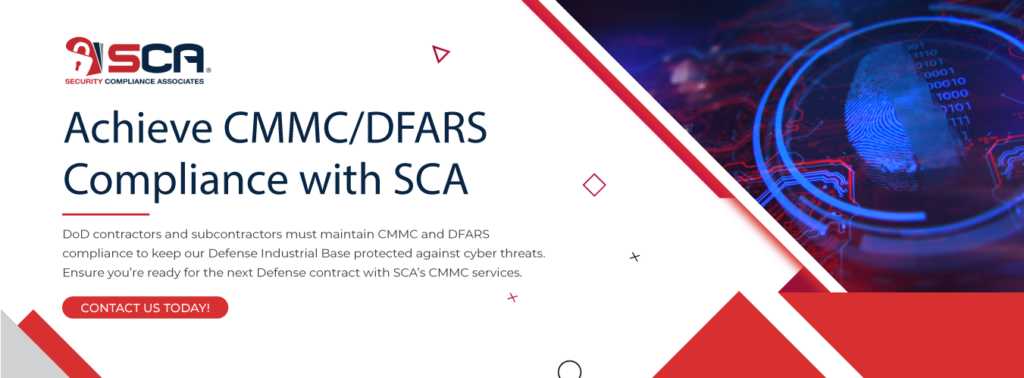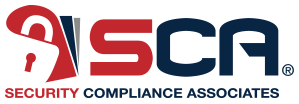
CMMC Compliance Checklist: Preparing For Your Audit
Working with the government on contracts is extremely important for all involved, but that doesn’t mean there isn’t usually some red tape. Preparing for a Cybersecurity Maturity Model Certification (CMMC) audit has become paramount. In this article, we delve into the essential elements of CMMC preparation, exploring the transition from CMMC to CMMC 2.0, key differences between the two, and the critical importance of achieving CMMC compliance.
From understanding the intricacies of CMMC maturity levels to implementing effective data handling and sensitivity criteria, SCA Security will guide you through a comprehensive overview of the preparation process.
Get the SCA CMMC 2.0 Compliance Checklist Now
Background: CMMC v2.0
CMMC v2 simplifies the original CMMC framework, reducing it from five levels of processes and practices to three simple requirement levels. As we note in each level, working with a team of experienced experts is critical to ensuring your organization is securing its data to meet the requirements. Failing to do so may result in a fine or even loss of contract opportunities.
CMMC v2.0 Level 1
This is the foundational cyber hygiene and basic safeguarding of Federal Contract Information (FCI). Level 1 includes 17 practices from Federal Acquisition Regulation (FAR) Clause 52.204-21. Following the CMMC Assessment Guide, 65 objectives allocated across the 17 Level 1 practices will be assessed. Understanding this distinction and the depth of evaluation required is essential. Working with an experienced team can be a great way to ensure your organization covers all the Level 1 practices necessary by the framework.
CMMC v2.0 Level 2
CMMC v2 goes deeper into the advanced cyber hygiene for companies protecting Controlled Unclassified Information (CUI). Level 2 includes 110 practices aligned with NIST 800-171 and satisfies Federal Acquisition Regulation Supplement (DFARS) clauses 252.204-7012, 252.204-7019 and 252.204-7020. Following the CMMC Assessment Guide, 343 objectives allocated across the 110 Level 2 practices will be assessed. It is important to understand this distinction and the depth of evaluation required.
CMMC v2.0 Level 3
CMMC v2.0 Level 3 concerns expert cyber hygiene for the highest priority programs with Controlled Unclassified Information (CUI). Level 3 contains 110 practices based on NIST 800-171 plus 24 additional select practices from NIST 800-172 for a total of 134 practices.
That sounds intimidating. Not only has the entire process been somewhat nebulous, but understanding where your organization fits within the new framework will probably require it not one but a team of experts. This article will help clarify where things have changed and how to prepare for your inevitable audit. If you want to keep contracting with the DoD, it will be coming, and it’s unclear exactly when.
Key Differences: CMMC and CMMC 2.0
Source: https://dodcio.defense.gov/CMMC/Model/
As pictured above, adjusting the CMMC structure was meant to simplify an extremely important yet confusing framework that essentially put national security at a higher level of risk. After receiving feedback from stakeholders over about two years through the review and suggestion process, the idea is for compliance to be more streamlined, with clear delimitations for each organization working with government data and on government networks.
Contractual agreements specify the required compliance level for contractors and subcontractors. While most companies will typically need to achieve and maintain either level 1 or level 2, it’s noteworthy that if your company has contracts with entities outside the Department of Defense, your entire organization need not comply with the full spectrum of CMMC. Cost efficiency can be achieved by restricting compliance efforts to the segments of your organization responsible for handling controlled, unclassified, and federal contract information.
Related Content: CMMC Training: Compliance for Contractors
Achieving CMMC Compliance
So, how do you prepare for the impending audit and ensure your organization doesn’t miss out on government contract opportunities? While there are no official penalties for noncompliance, you are essentially missing out on huge opportunities in various sectors if you don’t meet the minimum standards.
As a registered practitioner organization, SCA is here to help you navigate the intricacies of all these changes. First: START NOW. Do not think this is going to be a cut-and-dry process. You’ll have to go through a lot of information and ensure your entire team understands the whats, whys, and hows of the process. We’ve got you covered. Here are some of our top suggestions:
Data Assessment:
When preparing for an audit, you’ll first need to identify what data you have within your systems. The CMMC model is designed to protect federal contract information (FCI) and controlled unclassified information (CUI), which are shared with department contractors and subcontractors through acquisition programs.
Project Assessment
This entails a comprehensive analysis to determine the nature of the data held within the organization and the corresponding systems responsible for storing and handling such data. The assessment aims to meticulously identify and categorize the types of sensitive information involved, ranging from personally identifiable information (PII) to classified data. By understanding the intricacies of the data landscape and system architecture, organizations can lay the foundation for implementing robust cybersecurity measures aligned with CMMC requirements. This scoping phase sets the stage for a targeted and effective approach toward achieving and maintaining the desired level of cybersecurity maturity.
Readiness Assessment:
This evaluation is designed to gauge an organization’s current compliance with the CMMC framework and identify areas for improvement. The readiness assessment is a proactive measure that allows organizations to address vulnerabilities before undergoing a formal CMMC audit.
The process typically begins with a comprehensive review of the organization’s cybersecurity policies, procedures, and practices. This involves assessing the maturity of various cybersecurity controls, including data protection, access management, incident response, and more, based on the specific requirements of the CMMC framework.
Utilizing Existing Frameworks:
CMMC 2.0 is the DoD contracting requirement that leverages the use of existing cybersecurity frameworks to define where your cybersecurity framework can be improved while at the same time helping the organization ensure compliance. As mentioned, there is no legal requirement to achieve CMMC compliance, but it will certainly open doors for your organization’s contracting capabilities. Some other assessments we recommend as you go through the audit preparation process include a private security risk assessment, including pen testing and
Compliance with NIST SP 800-171:
Attaining NIST 800-171 compliance necessitates fulfilling all 110 controls outlined within the framework. To meet these requirements, contractors are required to formulate a System Security Plan (SSP) along with associated plans of action. The SSP plays a pivotal role in articulating the company’s approach to each of the 110 NIST controls, providing a comprehensive overview of how the organization addresses and satisfies these essential security measures.
Documentation and Updates:
Organizations should adopt a systematic and proactive approach to maintaining their System Security Plans (SSPs) to ensure the ongoing effectiveness of their cybersecurity measures. Periodically review and update the SSP to reflect changes in the organization’s IT environment, technology, personnel, and any other factors that may impact security.
Drafting Action Plans:
Similarly, it’s imperative to implement a robust action plan for a change management process to assess the security implications of any modifications to the system. Ensure that the SSP is updated accordingly to reflect these changes. Establish a continuous monitoring program to actively track and evaluate the system’s security posture. Regularly assess the effectiveness of security controls and update the SSP based on monitoring findings.
Gap Analysis:
Establish a baseline by comparing the current state against these benchmarks, uncovering areas of misalignment or potential vulnerabilities. Engage key stakeholders, including IT and security teams, to gather insights into existing security practices. Perform thorough risk assessments to pinpoint potential gaps in the security infrastructure. Prioritize identified gaps based on their severity and potential impact on the organization. Develop a comprehensive remediation plan with clear objectives, timelines, and resource allocation. Regularly revisit and update the security gap analysis as the organization evolves, ensuring a dynamic and adaptive approach to addressing emerging threats and maintaining robust cybersecurity measures.
Centralized Document Management:
Define key performance indicators (KPIs) and benchmarks based on industry standards and best practices in document management. Assess the efficiency, accessibility, and security of the current document storage and retrieval mechanisms. Engage relevant stakeholders, including document owners, IT personnel, and end-users, to gather insights into user experiences and requirements. Identify any inconsistencies or vulnerabilities in document handling, access controls, version control, and document lifecycle management.
Prioritize gaps based on their impact on operational efficiency, compliance, and data security. Develop a comprehensive improvement plan incorporating technology upgrades, user training, and procedural enhancements. Regularly review and update the centralized document management system to align with evolving organizational needs and industry advancements, ensuring an optimized and streamlined document handling and compliance approach.
Conducting thorough security and document management gap analyses is paramount for organizations that maintain robust cybersecurity and efficient operational workflows. By systematically assessing existing practices, aligning with industry benchmarks, and engaging stakeholders, organizations can pinpoint vulnerabilities and inefficiencies.
The prioritization and remediation of identified gaps through comprehensive plans ensure a proactive and adaptive security and document management approach. Regular reviews and updates guarantee these measures remain relevant and practical despite evolving threats and organizational changes. Ultimately, the commitment to continuous improvement through gap analyses is integral to fostering a resilient and secure organizational environment, safeguarding data, and enhancing overall operational efficiency.
SCA Security can help you with the complex steps to prepare you for your next CMMC v2.0 audit. Again, the timing is nebulous since there is no guaranteed or official date for the new requirements, but given the complexity of the process, there is always time to get started. Let SCA help you get started so your organization is ahead of the curve with the new requirements and ensure you keep your government contracts without issues.


